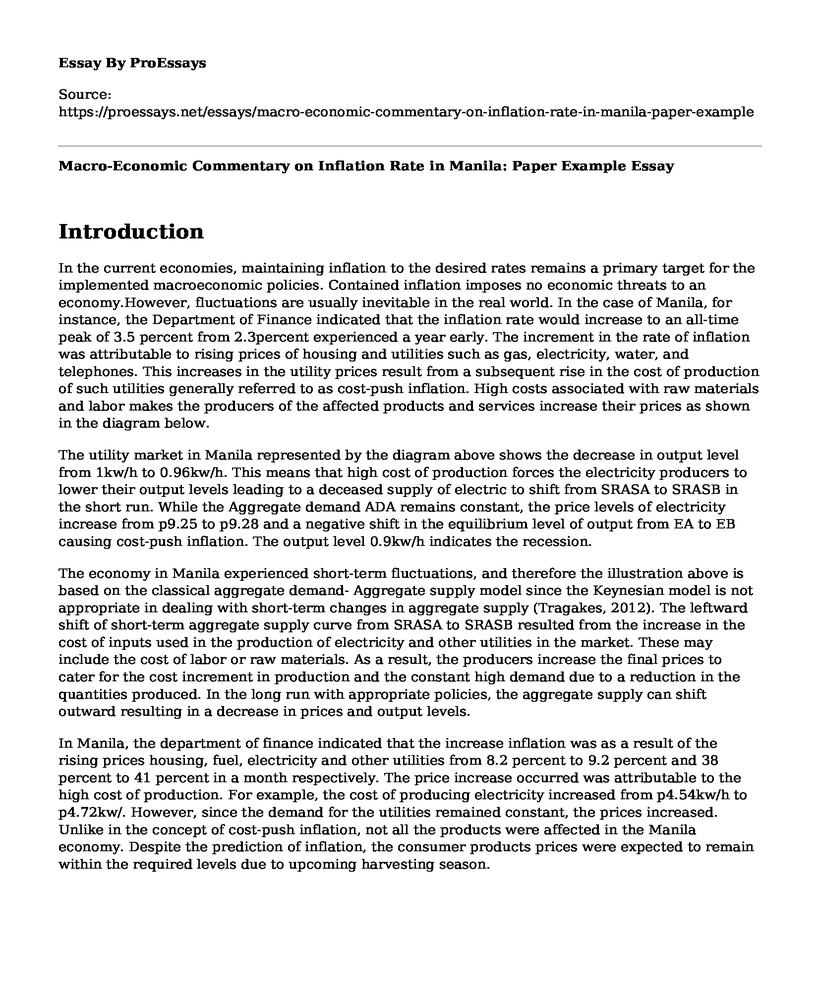Introduction
In the current economies, maintaining inflation to the desired rates remains a primary target for the implemented macroeconomic policies. Contained inflation imposes no economic threats to an economy.However, fluctuations are usually inevitable in the real world. In the case of Manila, for instance, the Department of Finance indicated that the inflation rate would increase to an all-time peak of 3.5 percent from 2.3percent experienced a year early. The increment in the rate of inflation was attributable to rising prices of housing and utilities such as gas, electricity, water, and telephones. This increases in the utility prices result from a subsequent rise in the cost of production of such utilities generally referred to as cost-push inflation. High costs associated with raw materials and labor makes the producers of the affected products and services increase their prices as shown in the diagram below.
The utility market in Manila represented by the diagram above shows the decrease in output level from 1kw/h to 0.96kw/h. This means that high cost of production forces the electricity producers to lower their output levels leading to a deceased supply of electric to shift from SRASA to SRASB in the short run. While the Aggregate demand ADA remains constant, the price levels of electricity increase from p9.25 to p9.28 and a negative shift in the equilibrium level of output from EA to EB causing cost-push inflation. The output level 0.9kw/h indicates the recession.
The economy in Manila experienced short-term fluctuations, and therefore the illustration above is based on the classical aggregate demand- Aggregate supply model since the Keynesian model is not appropriate in dealing with short-term changes in aggregate supply (Tragakes, 2012). The leftward shift of short-term aggregate supply curve from SRASA to SRASB resulted from the increase in the cost of inputs used in the production of electricity and other utilities in the market. These may include the cost of labor or raw materials. As a result, the producers increase the final prices to cater for the cost increment in production and the constant high demand due to a reduction in the quantities produced. In the long run with appropriate policies, the aggregate supply can shift outward resulting in a decrease in prices and output levels.
In Manila, the department of finance indicated that the increase inflation was as a result of the rising prices housing, fuel, electricity and other utilities from 8.2 percent to 9.2 percent and 38 percent to 41 percent in a month respectively. The price increase occurred was attributable to the high cost of production. For example, the cost of producing electricity increased from p4.54kw/h to p4.72kw/. However, since the demand for the utilities remained constant, the prices increased. Unlike in the concept of cost-push inflation, not all the products were affected in the Manila economy. Despite the prediction of inflation, the consumer products prices were expected to remain within the required levels due to upcoming harvesting season.
Solution Evaluation
Cost-push inflation is majorly caused by an increase in the production cost causing the inward shift of the SRAS curve and affects not the level of output but also the price levels. In this case the production and prices of utilities. When this happens, supply-side policies are most appropriate in containing the problem because they focus on the supply side of the economy, production, and measures aimed at moving the aggregate supply curve to the right to increase the output levels in the long run (Tragakes, 2012). The policies enhance output by improving organizational frameworks to increase the production capacity. The systems may be intervention or market based and are applicable depending on the primary cause of inflation.
The primary cause of inflation in Manila was an increase in prices of imported inputs such as fuel products which are essential in the production of electricity and other products. Since other consumer goods were not affected, the inflation rate is manageable through inflation targeting. This is a unique type of monetary policy that contains inflation within a target rate through improving internal development and steady interest rates. This policy applies to different kinds of inflation regardless of the cause.
Conclusion
Despite being a successful policy in maintaining stable and low levels of inflation, it reduces the ability of policymakers to peruse specific essential objectives such as reduction in the level of unemployment (Tragakes, 2012). For example, the high fuel prices in Manila that contribute to inflation, maintaining inflation target may lead cyclical unemployment. Unfortunately, this policy does not work all the time due to political and administrative goals of governments. An economy may require an increase in the rate of interest to contain inflation which in turn may to currency appreciation increasing the undesirable trade deficit.
Cited Page
Tragakes, E. (2012). Economics for the IB Diploma with CD-ROM. Cambridge University Press.
Cite this page
Macro-Economic Commentary on Inflation Rate in Manila: Paper Example. (2022, May 21). Retrieved from https://proessays.net/essays/macro-economic-commentary-on-inflation-rate-in-manila-paper-example
If you are the original author of this essay and no longer wish to have it published on the ProEssays website, please click below to request its removal:
- A Case Study of Zimbabwe's Gross Domestic Product
- Protecting a Business From Adverse Currency Movements
- Taxes and Unemployment Benefit Essay
- Nursing Shortage: Presenting the Problem Paper Example
- How Group Norms Exert Influence on an Individual's Behavior - Essay Sample
- Essay Sample on Social Impact of Business
- Essay Example on Monopolies: A Review of Competition & Regulation







